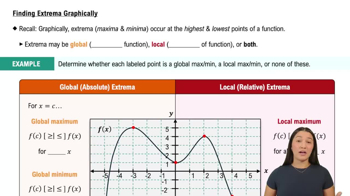Table of contents
- 0. Functions7h 52m
- Introduction to Functions16m
- Piecewise Functions10m
- Properties of Functions9m
- Common Functions1h 8m
- Transformations5m
- Combining Functions27m
- Exponent rules32m
- Exponential Functions28m
- Logarithmic Functions24m
- Properties of Logarithms34m
- Exponential & Logarithmic Equations35m
- Introduction to Trigonometric Functions38m
- Graphs of Trigonometric Functions44m
- Trigonometric Identities47m
- Inverse Trigonometric Functions48m
- 1. Limits and Continuity2h 2m
- 2. Intro to Derivatives1h 33m
- 3. Techniques of Differentiation3h 18m
- 4. Applications of Derivatives2h 38m
- 5. Graphical Applications of Derivatives6h 2m
- 6. Derivatives of Inverse, Exponential, & Logarithmic Functions2h 37m
- 7. Antiderivatives & Indefinite Integrals1h 26m
- 8. Definite Integrals3h 25m
5. Graphical Applications of Derivatives
Intro to Extrema
Problem 4.3.43
Textbook Question
Increasing and decreasing functions. Find the intervals on which f is increasing and the intervals on which it is decreasing.
f(x) = xe⁻(ˣ²/₂)
 Verified step by step guidance
Verified step by step guidance1
First, find the derivative of the function f(x) = xe^{-x²/2} using the product rule, since it is a product of two functions: x and e^{-x²/2}.
Set the derivative f'(x) equal to zero to find the critical points, as these points will help determine where the function changes from increasing to decreasing or vice versa.
Analyze the sign of the derivative f'(x) in the intervals determined by the critical points to identify where f(x) is increasing (f'(x) > 0) and where it is decreasing (f'(x) < 0).
Create a sign chart for f'(x) to visualize the intervals of increase and decrease based on the sign changes around the critical points.
Conclude by summarizing the intervals of increase and decrease based on your analysis of the sign chart.
Recommended similar problem, with video answer:
 Verified Solution
Verified SolutionThis video solution was recommended by our tutors as helpful for the problem above
Video duration:
7mPlay a video:
Was this helpful?

 5:58m
5:58mWatch next
Master Finding Extrema Graphically with a bite sized video explanation from Callie
Start learning





